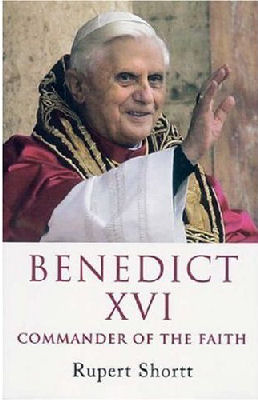
|
Posted January 23, 2007
Book: Benedict XVI: Commander of the Faith Author: Rupert Shortt Hidder & Stoughton. London. 2006. Pp. 164 An Excerpt from the Introduction:
. . .The pages ahead will have a good deal to report on matters of practical concern to Christians and others, including ethics, liturgy, ecumenism, interfaith dialogue, and the bonds between religion and politics. An Excerpt from the Book: A further swing of the pendulum came with publication of Benedict’s first encyclical, Deus Caritas Est (God is Love), a work as rich in pastoral warmth as anything in Salt of the Earth or God and the World. That the letter should focus on the stirrings of the heart (rather than some aspect of faith, for example) was considered significant in itself. Ideas about Benedict were further confounded by his emphasis on eros alongside agape (self-giving love), and his relative neglect of philia (the love between friends). Deus Caritas Est marks a substantial advance on John Paul’s encyclicals which were often long-winded. Its flavors are patristic and Augustinian: in other words, it assumes that we are made as desirous beings, drawn forward into exploration and growth by longing and hope. Love, then – of God and neighbor – is the key to all human flourishing. A good deal of theological reflection sees Christian love in terms of self-giving alone, and a mother’s devotion to her children as the epitome of love. The New Testament word for love is agape, not eros. Benedict, though, underlines the importance of love between a man and a woman, taking a lead from the Song of Songs, which also portrays God’s love for Israel in terms of erotic yearning. The Pope rejects Nietzsche’s claim that Christianity has destroyed eros. Desire is not wrong in itself: it simply needs to be channelled properly. So the sharp distinction sometimes drawn betwenn agape and eros is flawed. The two go together. This insight was welcomed by Janet Martin Soskice, the Catholic feminist philosopher, who wrote that ‘in this welcome restatement of the unity of the loves, the encyclical brings scholarship together with pastoral need.’ The first half of Deus Caritas Est proceeds to an exposition of core Catholic belief — that through the Eucharist we are bonded together in Christ, mediator of the new covenant, whose dying love has reconciled humanity to God. Part II, “The Practice of Love by the Church as a “Community of Love”’, gives some memorable examples of love in action. These include a comment by Tertullian (c.160-c.225) noting that pagans were constantly struck by the concern of Christians for the needy, and the action of Laurence, an early deacon in Rome. Commanded to hand over ecclesiastical treasures to the secular rulers, he shared what funds there were among the poor, and brought the poor before the authorities as the real treasure of the Church. Benedict grants that acts of charity are as important for Christians as the administration of the sacraments and the preaching of the word, and that practical discipleship has a broader dimension: “In today’s complex situation, not least because of the growth of a globalised economy, the Church’s social doctrine has become a set of fundamental guidelines offering approaches that are valid even beyond the confines of the Church: in the face of ongoing development these guidelines need to be addressed in the context of dialogue with all those seriously concerned for humanity and for the world in which we live.” This comment appears to be based on a nuanced grasp economics: global poverty is falling, thanks to free-market reforms in countries such as China and India, where most poor people live. A few paragraphs later, the encyclical moves onto less secure territory in maintaining that ‘the Church cannot and must not take upon herself the political battle to bring about the most just society possible’. There are three marks of authentic charity, the Pope suggests. It can entail ‘the simple response to immediate needs [such as] feeding the sick, visiting those in prison’; it is independent of parties and ideologies; and it ‘cannot be used as a means of engaging in what is nowadays considered proselytism.’ Some critics suggested that the first and second of these principles might entail the neglect of justice: freeing the slave, for example, but not opposing slavery as such. Mother Teresa is a case in point. She was regularly charged with overlooking the root cause of poverty, yet receives nothing but praise in Deus Caritas Est. As often elsewhere, however, Benedict’s arguments need to be seen against the backdrop of his antipathy towards Marxism. For his defenders, the point is that Christian charity should spring from love of God, and not from aspirations to construct this-worldly utopias. The Pope’s conclusion is resoundingly theological: “To experience love and in this way to cause the light of God to enter into the world — this is the invitation I would like to extend.” Table of Contents: 1. Boyhood 2. Studies 3. Vatican II in actuality and retrospect 4. Jumping ship 5. The Prefect’s project: an overview 6. Controversialist and apologist 7. The turn of the screw 8. The German shepherd 9. Enigma variations |
|
